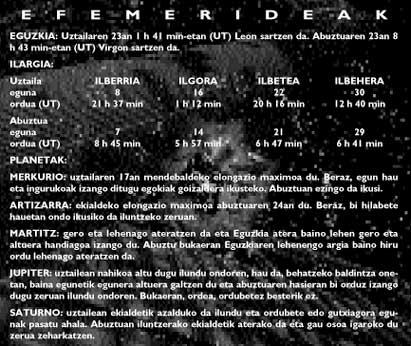Life Off Earth (and II)
In number 84 we ended with a mention of the efforts made to send messages from Earth. However, we mentioned that even if these messages had recipients, we would have to wait a long time for the response. Therefore, the work has not been aimed at sending messages, but at detecting the emissions generated by the possible other civilization.
Logically, this last work is huge. In short, we have to do the same to find a radio station that we don't know what frequency it broadcasts. But with an important difference, because the number of frequencies of our dial is huge. The lower frequency limit is given by the frequencies of the powerful synchrotron radiation emitters present in the galaxy, since any other emission made in this field would be covered. A gigahertia (16 Hz = 109 Hz) has been considered a minimum frequency. The upper limit is set by quantum noise, that is, the inevitable background noise that all electronic receivers have. This obstacle appears above 100 GHz. If we encounter traces of other living beings, the wave field to explore is between 1 and 100 GHz. (See image).

In this task the atmospheric absorption of the Earth is the first of the causes. Only radiation between 1 and 10 GHz reaches the earth's surface. However, since the optimal resolution of the observations would be 0.1 Hz, focusing the receiver towards a celestial medium would require a spectrometer of frequencies almost 1.011 different. Because our technology is not enough for such tools, the problem has been attacked from another point of view. Logically, the goal is to greatly reduce this wide frequency range based on logical criteria. As we are working on the detection of radiation produced by other civilizations, logic can be doubtful. However, at the proposal of different scientists, some frequencies have been considered more suitable to start the search tasks.
The frequency previously proposed, and probably the most used, was the line of 1.420 MHz (21 cm wavelength) corresponding to the emission of neutral hydrogen. Hydrogen is the most abundant element in the Universe, so the part of the spectrum surrounding its line is one of the best to infer information about the wide interstellar space and the evolution of stars and galaxies. Therefore, in the conviction that any other civilization that contained our technological level will also possess these peculiarities, it would not be surprising to consider the possibilities of this frequency of emission.
The difference between emissions generated in space or artificially would be found in the width of the line, in monochromaticity, since artificially emissions can be obtained almost monochromatic. Along with hydrogen, the radical oxhidril line (OH) was also proposed, which forms the essential water for the development of life along with hydrogen. As can be seen in the figure, the two stripes are contiguous and the frequencies between them give rise to what has been called “water hole”.
F. Drake (1960) was the first attempt to find extraterrestrial civilizations. Focus the Green Bank observatory antenna towards the stars Tau Ceti and Epsilon Eridani surrounding the Sun. The session lasted only 150 hours. The receiver had a single channel and searched for 1.420 Hz signals with a resolution of 100 Hz. Since then numerous projects have been carried out which have been offered more than 200,000 hours of observation.
These projects or programs are called SETI (Search for Extraterrestrial Intelligence), but SETI was actually the name of a program promoted by the Planetary Society in 1982. P. Horowitz designed a spectroscopic analyzer of 64,000 resolution channels 0.03 Hz. This analyzer has greatly improved and has received the name of the different projects. Currently it has 8,400,000 channels and two tools of this type: one at the Oak Bridge observatory and another at the “Argentine Institute of Radioastronomy”. Both organizations have a constantly functioning SETI program, but it is also the third observatory in the constant SETI exploration: From Ohio. They have been working there since 1973.
The programs are of two types: those that systematically analyze the sky without leaving parts and only explore the environments of the selected stars. The latter are performed by selecting stars similar to the Sun, type G. One of NASA's SETI programs at the Ames Research Center is studying 773 stars close to the Sun and similar to it. However, lately some scientists are asking that the search be extended to K-type stars, because they consider that these stars would have a wider region than G-class ones to create life.






